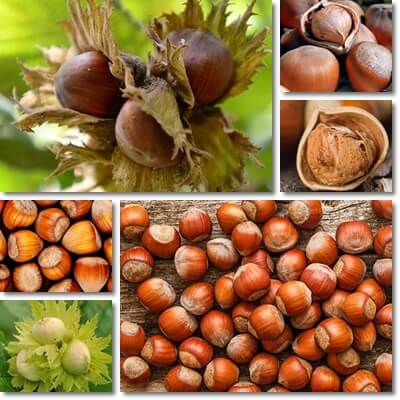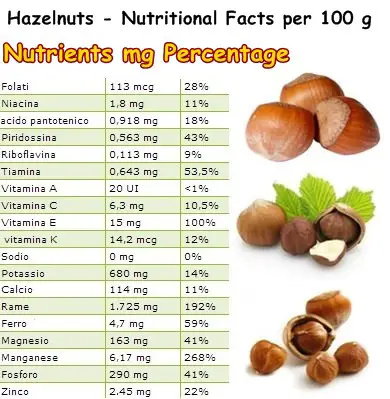Crunchy and full of flavor, hazelnuts are credited with some amazing properties and health benefits. The myriad of nutrients, antioxidants and fatty acids found in more than generous amounts in hazelnuts makes them one of the healthiest foods in the world. Regular consumption of preferably raw hazelnuts is thought to help improve overall health, and also increase life span due to the increased intake of almost all essential vitamins and minerals.
We can either consume them raw or indulge in a serving or two of dark, cocoa-rich, hazelnut chocolate; either way, hazelnuts are definitely a wonderful way of keeping ourselves healthy and happy.
They contain quite impressive amounts of essential dietary minerals such as copper and manganese, but also iron, magnesium and phosphorus, not to mention great levels of B vitamins and lots of vitamin E.

What do hazelnuts look like?
Hazelnut kernels are contained in a small, oval to round, hard shell. The shell has a beautiful yellow-brown, sometimes red color, very similar to the color of onion skins. The kernel is the prize of the hazel tree: this crunchy, savory interior is full of minerals, vitamins, antioxidants and fiber.
What do hazelnuts taste like?
Overall, the taste of hazelnuts is rich, intensely nutty with a creamy texture and mild fatty flavor notes. The kernels are best eaten raw and unsalted. Fried, salted hazelnuts may be a source of side effects over time as a result of the frying oils and added salt.
Nutrition facts and benefits of Hazelnuts
Hazelnuts are also an incredible source of energy, thanks to their high fat content: around 60.5%, with 82.8% oleic acid and 8.9% linoleic acid. Simply put, they are rich in unsaturated fatty acids which are essential for the good functioning of the entire body. For instance, consuming foods rich in essential fatty acids, such as hazelnuts, can help lower blood pressure and cholesterol levels, reduces the risk of stroke and heart attack and support the activity of the nervous system.
In addition to this, hazelnuts are rich in vitamin E, a potent antioxidant. Only 100 g of fresh kernels provides 100% of the recommended daily intake of the vitamin which offers protection against coronary heart disease and cancer, according to studies. Moreover, due to such a high vitamin E content, hazelnuts are a good food to eat for beautiful, radiant skin. More important, vitamin E combats dry skin by helping skin cells lock in moisture and exerts anti-aging effects by counteracting the damaging effects of free radicals.

Hazelnuts also contain beta-sitosterol, a natural plant sterol known to reduce cholesterol levels and protect against different forms of cancer such as breast, colon and prostrate cancer. Beta-sitosterol is currently under intense study because it is believed it can efficiently stop tumor growth and induce programmed cell death (apoptosis) in cancer cells.
Very important: hazelnuts are an incredible source of dietary minerals. Dietary minerals perform essential body functions, increase nutrient absorption, regulate body fluids, prevent fatigue, dizziness, irritability, combat stress and ensure a state of general well-being. 100 g of fresh hazelnut kernels, for example, provides almost half of the recommended daily intake of magnesium, one of the most heart-friendly minerals that exist.
Magnesium not only supports muscle activity, that of the heart included, but also optimizes both calcium and potassium absorption for both better cardiovascular health and nervous system function. Hazelnuts are a good source of calcium and potassium as well. Calcium helps strengthen bones while potassium regulates both blood pressure numbers and level of body fluids, helping correct water retention and puffiness.

In addition to this, hazelnuts provide 268% of the RDI of manganese, and 59% of the RDI of iron. Manganese is a potent antioxidant-vitamin, while iron prevent anemia. But most important, they rich in copper: 192% of the RDI. Copper boasts many incredible health benefits.
For instance, it is essential for healthy tissues and good vision. It also boasts anti-inflammatory effects and can alleviate arthritis pain. It can prevent premature graying of hair as well as premature aging.
Also, copper is a co-factor in numerous enzymatic processes and can efficiently support cognition. Think about it: only a helping of hazelnuts can help support a variety of body functions and improve your health considerably.
Hazelnuts are also a great source of protein and dietary fiber. Dietary fiber is a wonderful, all-natural remedy for constipation: eating a serving of hazelnuts every day will reduce both straining and time spent on the toilet which makes it a good food to eat for hemorrhoids too. Find out more about what foods to eat and to avoid for hemorrhoids.
Also, have you ever wondered why you always feel somewhat perky after eating a handful of hazelnuts? The answer is simple: hazelnuts contain generous amounts of B vitamins. Folate, niacin, thiamine, riboflavin, pyridoxine and pantothenic acid all combat mental and physical fatigue and boost energy levels, in addition to supporting nervous system activity and promoting skin health.
Hazelnuts are truly an amazing combination of vitamins, minerals, protein, fiber and fatty acids and can cater to almost all our dietary needs. Truth be told, all nuts, seeds and dried fruits have an astonishing high concentration of nutrients and phytochemicals with potent antioxidant effects. So, if you are allergic to hazelnuts, walnuts, chestnuts and so on, you needn’t worry: you can eat either dry fruits or seeds such as sesame seeds or poppy seeds, which are just as rich and healthy as any nut variety.
Hazelnuts side effects
Before consuming hazelnuts for the first time, or any kind of nuts for that matter, it might be best to undergo skin prick testing, especially if you have other nut allergies or multiple food allergies. This simple test can be easily performed by a specialized allergist and can reveal your reaction to the most common allergens. Herbs, nuts and even several fruits and vegetables can trigger allergic reactions in particularly sensitive individuals and may result in potentially life threatening outcomes such as anaphylactic shock.
